How to insulate a gas pipe on the street from condensation: an overview of the best materials and installation instructions
The operating parameters in the gas system are maintained thanks to a number of conditions, including the selection of suitable equipment and pipe material, the installation of regulators, properly completed installation, and compliance with operating rules. They do not take special efforts to stabilize the temperature, but in vain.
Despite compliance with all requirements for the installation of gas pipes, users often encounter condensation or freezing of the fuel mixture. To prevent this from happening, they carry out thermal insulation measures. In this article, we will consider how to insulate a gas pipe on the street, so that the system functions normally and even in severe frosts provides the house with heat. We supplement the material with visual photos and useful videos with recommendations for pipe insulation.
The content of the article:
Is it necessary to insulate the gas pipeline?
It is unlikely that you have encountered insulated pipes in urban conditions leading from gas distribution stations to residential buildings. Typically, a gas pipeline is laid underground - and then only waterproofing is made, without insulation. Or above-ground, when the pipes also protect against atmospheric and mechanical damage, without worrying about their thermal insulation.
In documents of information on additional insulation, there is also a minimum - and in SNiP 42-01-2002 (generally about systems), and in SNiP 41-03-2003 (on thermal insulation of pipelines).
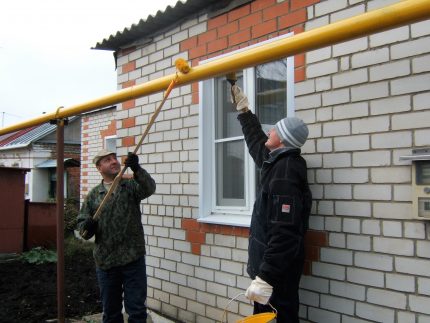
The lack of thermal insulation is explained by the properties of methane gas, which is supplied to the city stoves and columns. Its content in the fuel mixture reaches 70-93%, and the freezing temperature is -182.5 ° C. This means that even when methane is diluted with other impurities, it will not freeze in the winter conditions of the northern regions of Russia.
If methane is not freezing, then propane-butane mixture filled with cylinders and gas holders, sensitively reacts to a decrease in temperature. That is why the owners of private houses have to either independently, or by employees service organization to insulate sections of the gas pipeline located on the street.

Three critical areas potentially requiring additional thermal insulation can be distinguished:
- a piece of pipe from gas cylinders to the inlet in the wall of the house;
- pipe from the basement to the house, if gas is supplied from gas tank;
- a pipe section located in an unheated room - in a cold corridor, pantry, etc.
The underground gas pipeline does not require additional insulation. If it is enclosed in a special case-shell made of polyurethane foam, then in order to protect it from mechanical damage. The basement exit of the polyethylene pipe from the earth is placed in a case, it is also not thermally insulated.
The passage through the wall, according to the rules, also produce in case: the pipe is enclosed in a segment of a metal pipe of a larger diameter, and the voids are blocked with tow mixed with bitumen. Thus, this small section of the gas pipeline is already insulated.
Is it necessary in a particular case to insulate a gas pipe on the street, decide for the owners of the house. If the fuel supply system works without interruptions, then thermal insulation is not needed.
Preparing pipes for insulation
The fragments of the gas pipeline listed above that require additional thermal insulation can be steel or polyethylene - therefore, materials for warming such pipes you need to select the most suitable. It is better to wrap PE pipes with elastic sheet or tape material, and metal pipes with a heating cable or place them inside a PP shell.
In any case, before warming, the gas pipeline must be prepared. The recommended air temperature for installation works is +10 ° С, therefore it is better to postpone the events until the warm season.
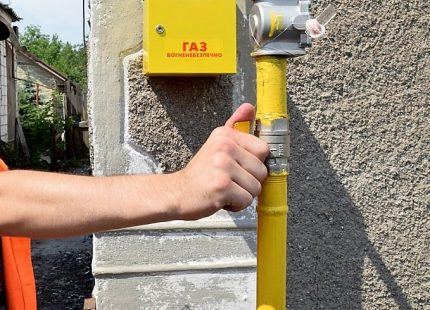
The insulated surface must be thoroughly cleaned of dust, dirt, grease, adhering street debris. We recommend using a special ethyl acetate-based cleaner. If thermal insulation is to be glued to a painted surface, make sure that there is sufficient adhesion.
Useful tips that are useful during the installation of pipe insulation:
- if you plan to use insulating tees, corners, bends, get ready to fix them first, and then isolate straight sections;
- expect that the glue, if used, will have to be applied both to the surface and to the insulation, and when gluing the ends - to the ends, and about 2 cm to the inner surface of the thermal insulation;
- stretch the insulation during installation, taking into account the linear expansion of the pipes;
- To give a holistic appearance, place all seams on the side of the wall.
We recommend that you also prepare a set of tools in advance: an adhesive brush, a stationery knife, a pair of compasses, scissors, punches, a miter box, a ruler, a tape measure, and a marker. For puttying, a spatula is useful.
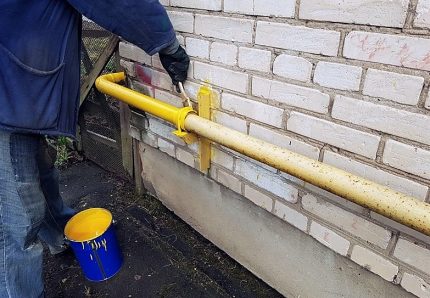
Before attaching the self-regulating cable, the steel pipe is also covered with a protective paint in 2 layers and produce grounding.
Popular types of materials + instructions
Consider the types of insulation, which are more appropriate to apply in modern conditions.It makes no sense to wrap the pipes with glass wool or cover with foam if effective materials based on polystyrene foam or polyurethane foam exist. Moreover, in addition to straight segments, you can also get ready-made curly elements - tees, bends, corners.
A few useful recommendations on how and how to insulate a gas pipe from condensate will help you independently eliminate the emergency situation and keep the gas pipeline functioning until the arrival of specialists.
Option # 1 - mineral wool based thermal insulation
Often, for the insulation of pipelines, inexpensive mineral wool cylinders are used, ordinary or foil. The advantages of insulation include incombustibility, environmental friendliness, biological resistance, quick and easy installation, excellent thermal insulation properties.
The main minus is fear of moisture. If water gets inside the cylinder, the material is destroyed, and under it rust forms on metal pipes.
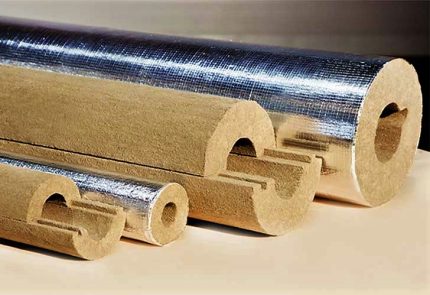
Cylinders that are not cached, that is, not covered with foil, cannot be used in a humid environment, therefore, they are not suitable for thermal insulation of a gas pipeline in the street. They can be used in dry indoor unheated rooms, the temperature in which drops below 0 ° C in winter.
You can find the requirements for the installation and operation of insulation from mineral wool in SNiP 41-03-2003developed instead of SNiP 2.04.14-88.
Thermal insulation rules:
- It is better to start fastening elements from flange connections.
- Fixation of the cylinders is carried out using bandages, packaging and aluminum tapes.
- Unpacked products must be wrapped with reinforced tape. It is also used if the top layer of foil cylinders is damaged.
- If it is noticed that moisture has penetrated under the insulation, it must be replaced.
Prior to installation, steel pipes must be treated to prevent corrosion. But it is better, if possible, to abandon the use of mineral wool and choose a moisture-proof insulation.
Option # 2 - shell PPP and PPU
Hard covers made of polyurethane foam and polystyrene foam, as well as basalt shells, are used actively. They have all the advantages of mineral wool, besides they practically do not absorb moisture.
They can be used both indoors and outdoors, and the main conditions for a long service life are compliance with installation rules and tightness.
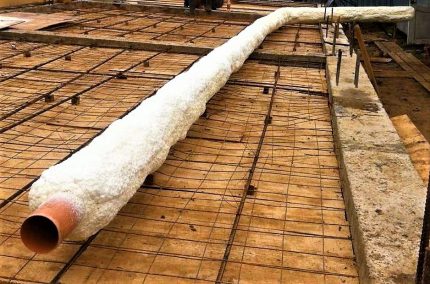
The technical characteristics of mineral wool are inferior to the PPU thermal insulation, the comparison results are shown in the table:

Products usually consist of two equal halves, which during installation are connected according to the principle Thorn groove. To achieve maximum tightness, seams and joints are sealed with foil tape. But a hard shell is not suitable for insulating fittings - you will have to use other materials.
It is important that the pipe is absolutely dry before installation! Even a little moisture can cause a greenhouse effect and corrosion.
Option # 3 - Thermaflex polyethylene “fur coat”
Thermaflex products have gained distribution due to their versatility, good thermal insulation properties, lightness, ease of fixation. This is a thermal insulation in the form of tubes with a cellular structure made of polyolefin or polyethylene. Suitable for all types of pipes, including gas.
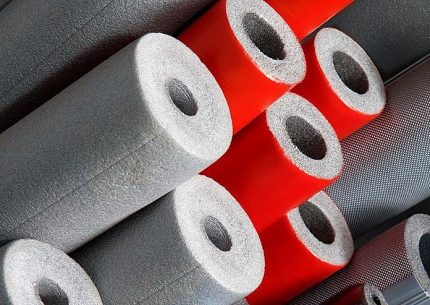
In addition to pipe and sheet material, the manufacturer produces several types of glue for attaching to pipes, polymer and aluminum tape, thermal tape, cleaner, clips and suspensions.
Instructions for use:
- Cut a straight piece of pipe material along the technological seam along the entire length, trying to keep the knife perpendicular to the surface.
- Put the insulation on the pipe so that the cut edges do not touch.
- Apply glue to the cut, adjacent parts of the pipeline and the inner side of the insulation - this is necessary so that the element does not move.
- Wait a few minutes until the glue dries. (from 2 to 12, depending on the temperature of the pipe);
- Connect the edges along the cut line, gently, in the direction from the ends to the middle.
- For greater reliability, use clipsplacing them along the seam with an interval of 20 cm.
Before gluing the next fragment, glue the end part, including the surface of the pipe, with glue. After 24 hours, remove the clips, and glue all the seams with tape.
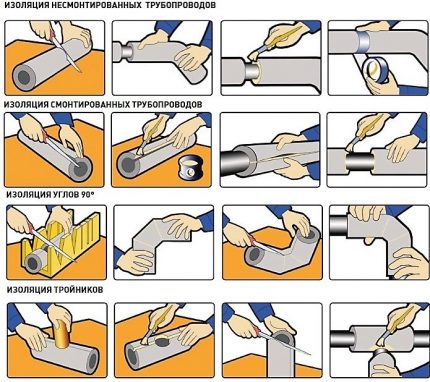
Thermaflex pipe is designed for insulation of gas pipelines with a diameter of up to 159 mm, if the pipe or shaped element is wider, we recommend the use of sheet material.
Surplus material will never disappear: along with gas pipes, it can also be insulated pipelines HVS and GVS, sewerage, tanks.
Option # 4 - self-regulating heating cable
Heating cables are used to protect pipelines from freezing or to maintain the desired temperature.
Owners of private houses suffering from condensation and freezing fuel in the cold season respond positively to the use of self-regulating cable - it really helps to forget about the troubles associated with the use of blue fuel.
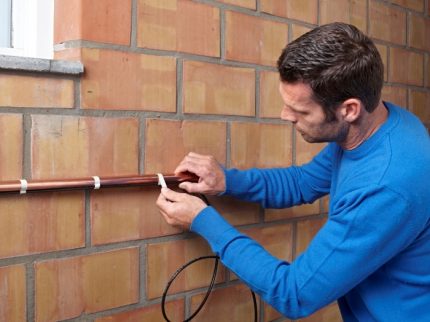
There are no restrictions on use: the cable is used for copper, steel, composite pipes, with and without thread. If, for mounting on plastic, an aluminum thermal tape is additionally fixed, then it is not needed for steel gas pipes.
The cable is laid in two ways:
- Stretching 2 or more parallel straight lines the entire length of the pipeline. For a gas pipe of 50 mm, 2 pieces are enough.
- Cable winding throughout the pipe, including tees and bends.
For protection, both pipes and cables are put on top of the insulation in one layer, preferably polymeric. If bitumen or solvent containing insulation is used, instead of the usual cable with fluoropolymer shell - it is important!
The installation procedure is simple: the cable is fixed on the previously prepared surface of the gas pipeline using one of the indicated methods, put on insulation, fix it with tape or a thermal tape. Then connect to the network using an adapter sleeve. We recommend to see the detailed cable installation instruction.
Conclusions and useful video on the topic
Methods of mounting a heating cable:
One of the options for attaching the PPU shell:
How to insulate pipe joints with Energoflex:
Insulation with rubber sheet material:
As you can see, the materials and methods for warming gas pipes in a private house can be different. Their choice depends on the specific conditions: the location and size of the pipeline, technical specifications, cost. All the materials listed in the article are universal, that is, they can be used for thermal insulation of any pipe communications.
Despite the ease of installation of heaters, we recommend that you first consult a specialist in the gas service to exclude the erroneous choice of material, and penalties from the service organization.
Recently engaged in pipe insulation and want to share your experience with other users? Write your recommendations, add photos of the finished work, participate in discussions - the comment form is located below.
If you still have questions about the topic of the above material, ask them to our experts in the feedback section.

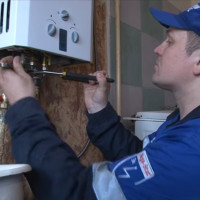 What to do when water gets into the gas pipe: a review of options for resolving the problem and possible consequences
What to do when water gets into the gas pipe: a review of options for resolving the problem and possible consequences  How to insulate a gas cylinder on the street in winter: the best ways to warm
How to insulate a gas cylinder on the street in winter: the best ways to warm 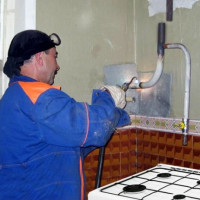 How to transfer a gas pipe in an apartment: transfer rules and location tips
How to transfer a gas pipe in an apartment: transfer rules and location tips 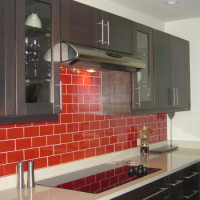 How to sheathe a gas stove: options and instructions for decorating the wall near the gas stove + security measures
How to sheathe a gas stove: options and instructions for decorating the wall near the gas stove + security measures  How to cut a pipe with gas: the procedure, rules and stages of work
How to cut a pipe with gas: the procedure, rules and stages of work 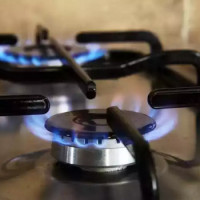 DIY gas stove connection: how to install a gas stove in an apartment step by step
DIY gas stove connection: how to install a gas stove in an apartment step by step  How much does it cost to connect gas to a private house: the price of organizing gas supply
How much does it cost to connect gas to a private house: the price of organizing gas supply  The best washing machines with dryer: model rating and customer tips
The best washing machines with dryer: model rating and customer tips  What is the color temperature of light and the nuances of choosing the temperature of the lamps to suit your needs
What is the color temperature of light and the nuances of choosing the temperature of the lamps to suit your needs  Replacement of a geyser in an apartment: replacement paperwork + basic norms and requirements
Replacement of a geyser in an apartment: replacement paperwork + basic norms and requirements